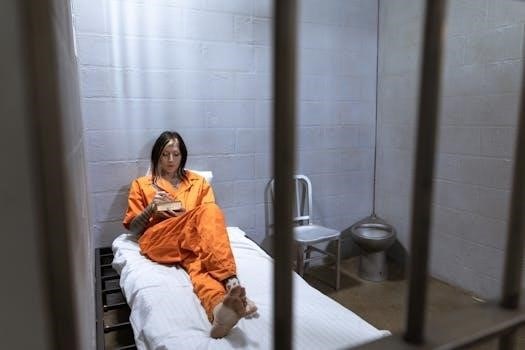A Clockwork Orange Book PDF⁚ A Comprehensive Guide
This guide explores the availability of “A Clockwork Orange” in PDF format, detailing its presence on platforms like Scribd and other download sites․ We delve into the nuances of accessing digital versions, noting varied formats including PDF, TXT, and DOC, and discussing how to obtain them․
Anthony Burgess’s “A Clockwork Orange,” a dystopian satirical black comedy novella published in 1962, presents a chilling vision of a future society grappling with youth violence and the complexities of free will․ The story follows Alex, a charismatic but ultra-violent teenager, and his gang as they engage in acts of “ultraviolence․” The novel explores themes of morality, social conditioning, and the nature of good and evil․ Set in a near-future England, it employs a unique fictional slang called Nadsat, which adds to its distinct and unsettling atmosphere․ The narrative structure, divided into three parts, each with seven chapters, is crucial to the story’s thematic development, though this structure isn’t always maintained in all editions․ It serves as a powerful social commentary on the consequences of societal decay and the dangers of dehumanization through technology and governmental control․ The book’s impact is far-reaching, influencing not only literature but also film and cultural discourse․ Its exploration of choice and consequence has made it a subject of ongoing study and debate․ The work’s enduring relevance lies in its ability to provoke crucial questions about human nature and the ethical implications of technological progress, often discussed in literary analysis․
Availability of PDF Versions
The digital age has made “A Clockwork Orange” readily accessible in PDF format, allowing readers to engage with Burgess’s work through various online platforms․ Numerous websites offer downloadable PDF versions of the novel, catering to diverse preferences with options like TXT and DOC files also available․ These digital copies are often found on sites that host e-books and academic resources, facilitating both casual reading and scholarly research․ While some PDF versions are free, others might be available through online libraries or subscription services, like Scribd, which often features a wide array of literary texts․ It is essential to verify the authenticity and completeness of a PDF before downloading, as quality can vary significantly across different sources․ Some digital versions might include supplementary materials such as introductory essays or critical analyses, adding value for academic users․ Additionally, the rise of ebook readers and applications has contributed to the wider distribution of “A Clockwork Orange” in digital formats․ The digital availability of the book allows it to reach a broader audience, especially those who may not have easy access to physical copies․ The convenience of PDF files enhances accessibility, allowing for study and reading anywhere with internet access․

Anthony Burgess and the Novel
Anthony Burgess, the English author behind “A Clockwork Orange,” was a prolific writer and composer whose works often explored themes of free will and societal control․ Born in 1917, Burgess created this dystopian novella in 1962, drawing on his experiences and philosophical interests to craft a narrative that blends social commentary with linguistic innovation․ The novel was initially conceived as part of a series of books about imaginary futures, showcasing Burgess’s fascination with exploring potential societal trajectories․ Burgess’s intent was to provoke thought about the nature of good and evil, using extreme violence and a unique fictional language to challenge readers’ perspectives․ His own life, marked by personal struggles and cultural observations, profoundly influenced the themes and tone of the novel․ He was not just a novelist; his diverse talents included composing music and creating plays, enriching his narrative work with a multifaceted understanding of art․ Burgess’s engagement with the book extended into adaptations for stage, further demonstrating his commitment to exploring the story’s various dimensions․ This dedication highlights the depth and complexity of his vision for “A Clockwork Orange,” which continues to intrigue and provoke readers today․
The Novel’s Structure and Content
“A Clockwork Orange” is structured into three distinct sections, each containing seven chapters, a deliberate choice by Burgess to mirror the themes of the narrative․ The novel’s content revolves around the violent exploits of Alex and his gang, exploring their descent into ultra-violence and the subsequent government intervention through aversion therapy․ The narrative’s focus is on Alex’s journey, illustrating a stark dystopian society where personal freedom battles against enforced morality․ Burgess uses extreme violence to shock and provoke, while the plot delves into questions of good versus evil, and the consequences of removing free will․ The book examines not only physical brutality but also the psychological impact of conditioning․ The novel’s structure is a reflection of its themes, with the three-part division highlighting the different stages of Alex’s experience—his initial violence, his forced rehabilitation, and his eventual return to his former self․ This meticulous structure reinforces the complex layers of meaning within the novel, inviting readers to contemplate the nature of humanity and control․
Nadsat⁚ The Fictional Language
Nadsat, the fictional slang used by Alex and his droogs, is a crucial element of “A Clockwork Orange,” contributing significantly to its unique style and dystopian atmosphere․ This argot, a blend of Russian, Cockney rhyming slang, and other influences, creates a sense of alienation and otherness, immersing the reader in the novel’s futuristic world․ It is not merely a collection of invented words but a tool to highlight the characters’ detachment from mainstream society and their rebellious tendencies․ Nadsat adds a layer of complexity to the narrative, challenging readers to decipher its meanings, which often relate to violence, sex, and everyday objects․ The language serves to distance the reader while simultaneously creating a sense of intimacy with Alex’s perspective․ The use of Nadsat makes the novel linguistically challenging, requiring the reader to actively engage with the text․ Its presence underscores the novel’s themes of societal breakdown, youth rebellion, and the manipulation of language itself․
Translation Challenges
Translating “A Clockwork Orange” presents significant challenges, primarily due to the presence of Nadsat, the novel’s unique fictional language․ Nadsat, a mixture of Russian, Cockney slang, and invented words, is not easily translatable into other languages while maintaining its original intent and effect․ Translators must grapple with how to convey the sense of otherness, alienation, and youthful slang that Nadsat creates in the original text․ The challenge lies in finding equivalents in the target language that can replicate the same level of linguistic distortion and cultural connotations․ Different translators have approached this problem in various ways, sometimes creating their own unique slang or borrowing from existing subcultures․ The choices made in translation significantly impact the reader’s experience and interpretation of the novel․ Moreover, the rhythm and flow of the original text, often influenced by Nadsat, must also be carefully considered to maintain the novel’s unique voice and style․ The translation process highlights the inherent difficulty of moving a text deeply rooted in a specific linguistic and cultural context into another․
“A Clockwork Orange” as a Play

“A Clockwork Orange” has been adapted into a stage play, demonstrating the novel’s versatility beyond the printed page․ Anthony Burgess himself created a stage adaptation, titled “A Clockwork Orange⁚ A Play With Music,” which premiered in 1987․ This version brings the narrative to life through dramatic action and musical elements, creating a different experience compared to reading the book or watching the film․ The stage play allows for a more direct engagement with the characters and their motivations, and it often emphasizes the themes of free will and social control through theatrical techniques․ The theatrical adaptation also explores the dark and violent aspects of the story through a different medium, sometimes using stylized movements or exaggerated expressions to convey the extreme nature of the novel’s content․ Productions of the play often vary in their interpretations, providing a range of perspectives on Burgess’s complex narrative․ The play represents another facet of the novel’s enduring appeal and its ability to resonate across multiple art forms․ It also highlights the challenges of adapting such a linguistically dense work for live performance․
Stanley Kubrick’s Film Adaptation
Stanley Kubrick’s 1971 film adaptation of “A Clockwork Orange” is a landmark in cinema, translating the novel’s dystopian world and violent themes to the screen with striking visual style․ Kubrick’s film is known for its iconic imagery, including the milk bar and Alex’s distinctive droog attire․ The movie captures the brutal essence of the story, using a blend of stylized violence and disturbing imagery․ Kubrick’s adaptation, while faithful to the book’s core narrative, also introduces its own interpretations and artistic choices, leading to some variations in plot and character portrayal․ The film’s use of music, particularly classical pieces juxtaposed with violent scenes, enhances the unsettling mood․ Kubrick’s direction emphasizes the themes of free will, morality, and the consequences of violence, creating a film that is both visually stunning and intellectually provocative․ The movie also generated controversy upon its release, due to its graphic depiction of violence․ Despite or perhaps because of this, it remains a highly influential and frequently debated adaptation․
Intertextuality and Adaptation
The concept of intertextuality plays a crucial role in understanding “A Clockwork Orange,” both in its original novel form and in its various adaptations․ The novel itself draws on a range of literary and philosophical influences, creating a rich tapestry of references and allusions․ Stanley Kubrick’s film adaptation further layers this intertextual complexity by adding cinematic references and visual cues, thus engaging in a dialogue with the source material and other works․ The adaptation process involves not only transferring the story from page to screen but also reinterpreting and reshaping it through a new medium․ The film engages with the novel’s themes and characters, but it also introduces its own unique perspective, making it a distinct work that both echoes and diverges from the original․ This interplay between the novel, the film, and other related works contributes to the ongoing critical discourse surrounding “A Clockwork Orange” and its enduring cultural impact․ The adaptation highlights how stories are constantly reinterpreted and reshaped within new contexts․

The American Edition Controversy
The American edition of “A Clockwork Orange” sparked significant controversy due to its omission of the final chapter, which fundamentally altered the novel’s message․ This editorial decision, made without Anthony Burgess’s consent, presented a more pessimistic view of human nature and the possibility of redemption․ The removal of the chapter, where Alex expresses a desire to grow up and leave behind his violent past, caused a critical shift in the novel’s intended arc․ The American version suggests that violence and depravity are inescapable, while the original British edition offers a glimmer of hope for change․ This discrepancy led to a considerable debate about the integrity of the author’s work and the impact of editorial decisions on literary interpretation․ The controversy underscores the complex relationship between authorial intent, editorial intervention, and reader perception․ This difference also significantly affected the novel’s reception and how it has been understood in different cultural contexts․ The debate still resonates among literary scholars․
Themes and Interpretations
“A Clockwork Orange” delves into several profound themes, including free will versus determinism, the nature of good and evil, and the impact of societal conditioning on individual behavior․ The novel explores the concept of moral choice and whether it can be imposed or if it must arise from within․ The brutal violence perpetrated by Alex and his droogs raises questions about the root causes of delinquency and the effectiveness of traditional methods of punishment and rehabilitation․ The Ludovico Technique, a form of aversion therapy, exemplifies the novel’s exploration of the ethics of behavior modification․ Furthermore, the work challenges the reader to consider whether true goodness can be achieved through coercion or if it requires genuine autonomy․ The novel’s dystopian setting serves as a backdrop for examining the fragility of civilization and the potential for societal breakdown․ Interpretations of the novel vary widely, with some seeing it as a cautionary tale about the dangers of totalitarianism, while others view it as a complex study of human psychology and the limits of social control․ The themes continue to provoke debate and reflection․
Critical Reception and Legacy
“A Clockwork Orange” has garnered a complex critical reception since its publication, with opinions ranging from praise for its innovative style and challenging themes to condemnation for its explicit violence and moral ambiguity․ Initially, the novel was met with mixed reviews, with some critics expressing discomfort with its depiction of graphic violence and the amoral character of Alex․ However, over time, the book has been recognized for its literary merit and its exploration of philosophical and social issues․ The novel’s unique use of the fictional language Nadsat, its exploration of free will, and its critique of societal control have all contributed to its enduring legacy․ The novel has been the subject of much academic analysis, with scholars focusing on its themes, structure, and linguistic innovation․ Its impact on popular culture is undeniable, inspiring numerous adaptations, including Stanley Kubrick’s famous film and stage productions․ The book remains a controversial work, but it continues to be widely read and debated, solidifying its place in literary history․ The discussions surrounding “A Clockwork Orange” highlight the complexities of moral interpretation in literature․
Where to Find the PDF
Locating a PDF version of “A Clockwork Orange” can be achieved through various online platforms․ Scribd is one such resource, often hosting user-uploaded documents, including the novel in PDF format․ Additionally, numerous websites offer digital downloads of the book; however, it is crucial to exercise caution and verify the legitimacy of the source before downloading․ Some educational websites and online libraries may also provide access to the novel in PDF form as part of their digital collections․ Platforms like Amazon sometimes offer links to digital versions of books, though direct PDF availability varies․ Furthermore, forums and online communities dedicated to literature may host links or discussions regarding where to find legitimate PDF versions․ When searching online, it is advisable to use specific keywords such as “A Clockwork Orange PDF download” to refine your search results․ Always prioritize legal and reputable sources to avoid any copyright infringements or potential security risks․ Remember to check for user reviews and ratings if available, which can help in determining the quality of the PDF file․

